Effects of Nanosecond Repetitively Pulsed Discharges Timing for Aeroengines Ignition at Low Temperature Conditions by Needle-Ring Plasma Actuator
Abstract
:1. Introduction
2. Materials and Methods
3. Numerical Procedure
4. Results and Discussions
4.1. Experimental Results
4.1.1. Electrical Characterization
4.1.2. Flow Visualization and Proper Orthogonal Decomposition (POD)
4.2. ZDPlaskin Results
4.3. CHEMKIN Results: Effects of Pulses Number on Flame Ignition Characteristics
5. Conclusions
Author Contributions
Funding

Institutional Review Board Statement
Informed Consent Statement
Data Availability Statement
Acknowledgments
Conflicts of Interest
References
- Oh, J.; Noh, D. Flame characteristics of a non-premixed oxy-fuel jet in a lab-scale furnace. Energy 2015, 81, 328–343. [Google Scholar] [CrossRef]
- Lee, S.; Padilla, R.; Dunn-Rankin, D.; Pham, T.; Kwon, O.C. Extinction limits and structure of counter flow non premixed H2O-laden CH4/air flames. Energy 2015, 93, 442–450. [Google Scholar] [CrossRef] [Green Version]
- Egolfopoulos, F.N.; Holley, A.T.; Law, C.K. An assessment of the lean flammability limits of CH4/air and C3H8/air mixtures at engin*10-like conditions. Proc. Combust. Inst. 2007, 31, 3015–3022. [Google Scholar] [CrossRef]
- Cha, M.S.; Chung, S.H. Characteristics of lifted flames in non-premixed turbulent confined jets. Symp. Int. Combust. 1996, 26, 121–128. [Google Scholar] [CrossRef]
- Stange, S.; Kim, Y.; Ferreri, V.; Rosocha, L.; Coates, D. Flame images indicating combustion enhancement by dielectric barrier discharges. IEEE Trans. Plasma Sci. 2005, 33, 316–317. [Google Scholar] [CrossRef]
- de Giorgi, M.G.; Sciolti, A.; Campilongo, S.; Pescini, E.; Ficarella, A.; Martini, L.M.; Tosi, P.; Dilecce, G. Plasma assisted flame stabilization in a non-premixed lean burner. Energy Proc. 2015, 82, 410–416. [Google Scholar] [CrossRef] [Green Version]
- De Giorgi, M.G.; Sciolti, A.; Campilongo, S.; Pescini, E.; Ficarella, A.; Lovascio, S.; Dilecce, G. Lean Blowout Sensing and Plasma Actuation of Non-Premixed Flames. IEEE Sens. J. 2016, 16, 3896–3903. [Google Scholar] [CrossRef]
- De Giorgi, M.G.; Ficarella, A.; Sciolti, A.; Campilongo, S.; Pescini, E.; Dilecce, G. Effect of actuation parameters on stabilization of methane diffusive flames using plasma actuators. In Proceedings of the XXXVIII Meeting of the Italian Section of the Combustion Institute, Lecce, Italy, 20–23 September 2015. [Google Scholar] [CrossRef]
- Huang, D.Q.; Yu, J.L.; Wang, S.B.; Li, Q.Y.; He, L.M. The experiment investigation on the characteristics of pre-combustion plasma jet ignition. High Volt. Eng. 2018, 44, 3068–3075. [Google Scholar]
- Mintoussov, E.; Pancheshnyi, S.; Starikovskii, A. Propane-Air Flame Control by Non-Equilibrium Low-temperature Pulsed Nanosecond Barrier Discharge. In Proceedings of the 42nd AIAA Aerospace Sciences Meeting and Exhibit, Reno, NV, USA, 5–8 January 2004. [Google Scholar]
- Bak, M.S.; Im, S.-K.; Mungal, M.G.; Cappelli, M.A. Studies on the stability limit extension of premixed and jet diffusion flames of methane, ethane, and propane using nanosecond repetitive pulsed discharge plasmas. Combust. Flame 2013, 160, 2396–2403. [Google Scholar] [CrossRef]
- Ruma, M.; Ahasan, H.; Ranipet, H.B. A Survey of non-thermal plasma and their generation methods. Int. J. Renew. Energy Environ. Eng. 2016, 4, 6–12. [Google Scholar]
- Starikovskiy, A.; Aleksandrov, N. Mechanism of Plasma-Assisted Ignition for H2 and C1-C5 Hydrocarbons. In Proceedings of the 55th AIAA Aerospace Sciences Meeting, Grapevine, TX, USA, 9–13 January 2017. AIAA Paper 2017-1977. [Google Scholar]
- Ju, Y.; Sun, W. Plasma assisted combustion: Dynamics and chemistry. Prog. Energy Combust. Sci. 2015, 48, 21–83. [Google Scholar] [CrossRef]
- Tholin, F.; Lacoste, D.A.; Bourdon, A. Influence of Fast-Heating Processes and OAtom Production by a Nanosecond Spark Discharge on the Ignition of a Lean H2-Air Premixed Flame. Combust. Flame 2014, 161, 1235–1246. [Google Scholar] [CrossRef]
- Aleksandrov, N.L.; Kindysheva, S.V.; Kukaev, E.N.; Starikovskaya, S.M.; Starikovskii, A.Y. Simulation of the ignition of a methane-air mixture by a high-voltage nanosecond discharge. Plasma Phys. Rep. 2009, 35, 867–882. [Google Scholar] [CrossRef]
- Kosarev, I.; Aleksandrov, N.; Kindysheva, S.; Starikovskaia, S.; Starikovskii, A. Kinetics of ignition of saturated hydrocarbons by nonequilibrium plasma: CH4-containing mixtures. Combust. Flame 2008, 154, 569–586. [Google Scholar] [CrossRef]
- Yang, S.; Nagaraja, S.; Sun, W.; Yang, V. Multiscale modeling and general theory of non-equilibrium plasma-assisted ignition and combustion. J. Phys. D Appl. Phys. 2017, 50, 433001. [Google Scholar] [CrossRef]
- Xu, C.H.; Li, L. Electric Effects on the Pre-Mixing Process in DBD Assisted Combustions. Appl. Mech. Mater. 2015, 722, 235–238. [Google Scholar] [CrossRef]
- Benard, N.; Braud, P.; Pons, J.; Touchard, G.; Moreau, E. Quasi-steady and unsteady actuation by surface non-thermal plasma discharge for control of a turbulent round air jet. J. Turbul. 2007, 8, N49. [Google Scholar] [CrossRef]
- Benard, N.; Bonnet, J.P.; Touchard, G.; Moreau, E. Flow Control by Dielectric Barrier Discharge Actuators: Jet Mixing Enhancement. AIAA J. 2008, 46, 2293–2305. [Google Scholar] [CrossRef]
- De Giorgi, M.G.; Ficarella, A.; Fontanarosa, D.; Pescini, E.; Suma, A. Investigation of the Effects of Plasma Discharges on Methane Decomposition for Combustion Enhancement of a Lean Flame. Energies 2020, 13, 1452. [Google Scholar] [CrossRef] [Green Version]
- Pescini, E.; Martínez, D.; De Giorgi, M.G.; Ficarella, A. Characterization of the effects of a dielectric barrier discharge plasma actuator on a coaxial jet in a Bunsen burner. Exp. Therm. Fluid Sci. 2018, 91, 292–305. [Google Scholar] [CrossRef]
- De Giorgi, M.G.; Ficarella, A.; Sciolti, A.; Pescini, E.; Campilongo, S.; Di Lecce, G. Improvement of lean flame stability of inverse methane/air diffusion flame by using coaxial dielectric plasma discharge actuators. Energy 2017, 126, 689–706. [Google Scholar] [CrossRef]
- Rosocha, L.A.; Kim, Y.; Anderson, G.K.; Abbate, S. Combustion enhancement using silent electrical discharges. Int. J. Plasma Environ. Sci. Technol. 2007, 1, 8–13. [Google Scholar]
- Zhang, X.; Cha, M.S. Electron-induced dry reforming of methane in a temperature-controlled dielectric barrier discharge reactor. J. Phys. D Appl. Phys. 2013, 46, 415205. [Google Scholar] [CrossRef]
- Zhang, X.; Cha, M.S. Partial oxidation of methane in a temperature-controlled dielectric barrier discharge reactor. Proc. Combust. Inst. 2014, 35, 3447–3454. [Google Scholar] [CrossRef]
- Mu, H.; Yu, L.; Li, P.; Tang, C.; Wang, J.; Zhang, G.; Haibao, M.; Lin, Y.; Ping, L.; Chenglong, T.; et al. Study on the Enhancement Effect of Dielectric Barrier Discharge on the Premixed Methane/Oxygen/Helium Flame Velocity. Plasma Sci. Technol. 2015, 17, 1019–1026. [Google Scholar] [CrossRef]
- Pescini, E.; Francioso, L.; De Giorgi, M.G.; Ficarella, A. Investigation of a Micro Dielectric Barrier Discharge Plasma Actuator for Regional Aircraft Active Flow Control. IEEE Trans. Plasma Sci. 2015, 43, 3668–3680. [Google Scholar] [CrossRef]
- Pescini, E.; De Giorgi, M.G.; Francioso, L.; Sciolti, A.; Ficarella, A. Effect of a micro dielectric barrier discharge plasma actuator on quiescent flow. IET Sci. Meas. Technol. 2014, 8, 135–142. [Google Scholar] [CrossRef]
- Pancheshnyi, S.; Eismann, B.; Hagelaar, G.J.M.; Pitchford, L.C. 2008. Available online: http://www.zdplaskin.laplace.univ-tlse.fr (accessed on 14 June 2021).
- Lutz, A.E.; Kee, R.J.; Miller, J.A. SENKIN: A FORTRAN Program for Predicting Homogeneous Gas Phase Chemical Kinetics with Sensitivity Analysis; Sandia National Labs.: Livermore, CA, USA, 1988.
- Lefkowitz, J.K.; Guo, P.; Rousso, A.; Ju, Y. Species and temperature measurements of methane oxidation in a nanosecond repetitively pulsed discharge. Philos. Trans. R. Soc. A Math. Phys. Eng. Sci. 2015, 373, 20140333. [Google Scholar] [CrossRef] [Green Version]
- Wang, Y.; Guo, P.; Chen, H.; Chen, Z. Numerical modeling of ignition enhancement using repetitive nanosecond discharge in a hydrogen/air mixture I: Calculations assuming homogeneous ignition. J. Phys. D Appl. Phys. 2021, 54, 065501. [Google Scholar] [CrossRef]
- Capitelli, M.; Ferreira, C.M.; Gordiets, B.F.; Osipov, I.A. Plasma Kinetics in Atmospheric Gases. Plasma Phys. Control. Fusion 2001, 43, 371–372. [Google Scholar] [CrossRef]
- Flitti, A.; Pancheshnyi, S. Gas heating in fast pulsed discharges in N2–O2mixtures. Eur. Phys. J. Appl. Phys. 2009, 45, 21001. [Google Scholar] [CrossRef] [Green Version]
- Mao, X.; Rousso, A.; Chen, Q.; Ju, Y. Numerical modeling of ignition enhancement of CH4/O2/He mixtures using a hybrid repetitive nanosecond and DC discharge. Proc. Combust. Inst. 2019, 37, 5545–5552. [Google Scholar] [CrossRef]
- Mao, X.; Chen, Q.; Guo, C. Methane pyrolysis with N2/Ar/He diluents in a repetitively-pulsed nanosecond discharge: Kinetics development for plasma assisted combustion and fuel reforming. Energy Convers. Manag. 2019, 200, 112018. [Google Scholar] [CrossRef]
- DeFilippo, A.C. Microwave-Assisted Ignition for Improved Internal Combustion Engine Efficiency. Ph.D. Thesis, University of California, Berkeley, CA, USA, 2013. [Google Scholar]
- Fontanarosa, D.; Mehdi, G.; De Giorgi, M.G.; Ficarella, A. Assessment of the impact of nanosecond plasma discharge on the combustion of methane air flames. E3S Web Conf. 2020, 197, 10001. [Google Scholar] [CrossRef]
- Patel, R.B.; Oommen, C.; Thomas, M.J. Influence of Reduced Electric Field (E/N) on Plasma-Assisted Low-Temperature Oxidation. J. Propuls. Power 2020, 36, 235–247. [Google Scholar] [CrossRef]
- Zuiderveld, K. Contrast Limited Adaptive Histogram Equalization. Graph. Gems IV 1994, 474–485. [Google Scholar] [CrossRef]
- Thielicke, W. The Flapping Flight of Birds—Analysis and Application. Ph.D. Thesis, University of Groningen, Groningen, The Netherlands, 2014. Available online: http://irs.ub.rug.nl/ppn/382783069 (accessed on 14 June 2021).
- Uddi, M.; Jiang, N.; Mintusov, E.; Adamovich, I.; Lempert, W.R. Atomic oxygen measurements in air and air/fuel nanosecond pulse discharges by two photon laser induced fluorescence. Proc. Combust. Inst. 2009, 32, 929–936. [Google Scholar] [CrossRef]
- Halter, F.; Higelin, P.; Dagaut, P. Experimental and Detailed Kinetic Modeling Study of the Effect of Ozone on the Combustion of Methane. Energy Fuels 2011, 25, 2909–2916. [Google Scholar] [CrossRef]

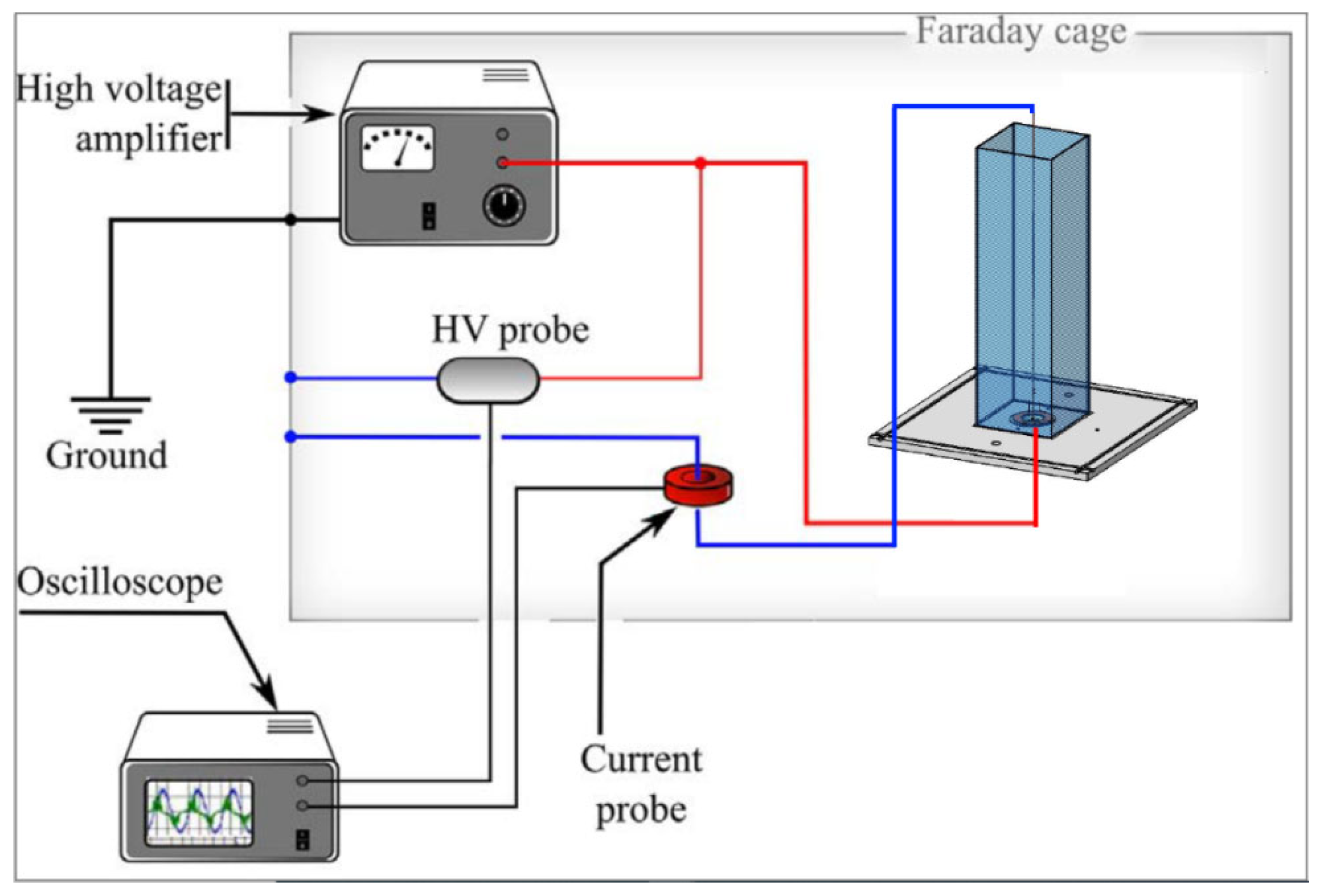



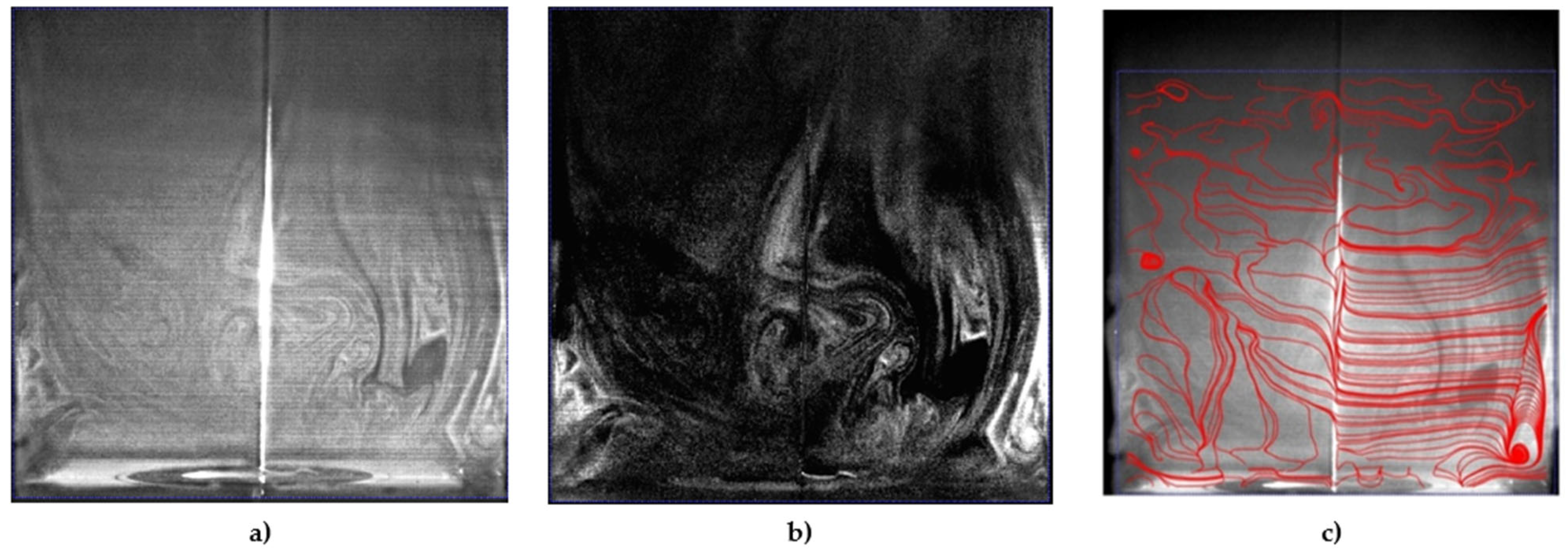
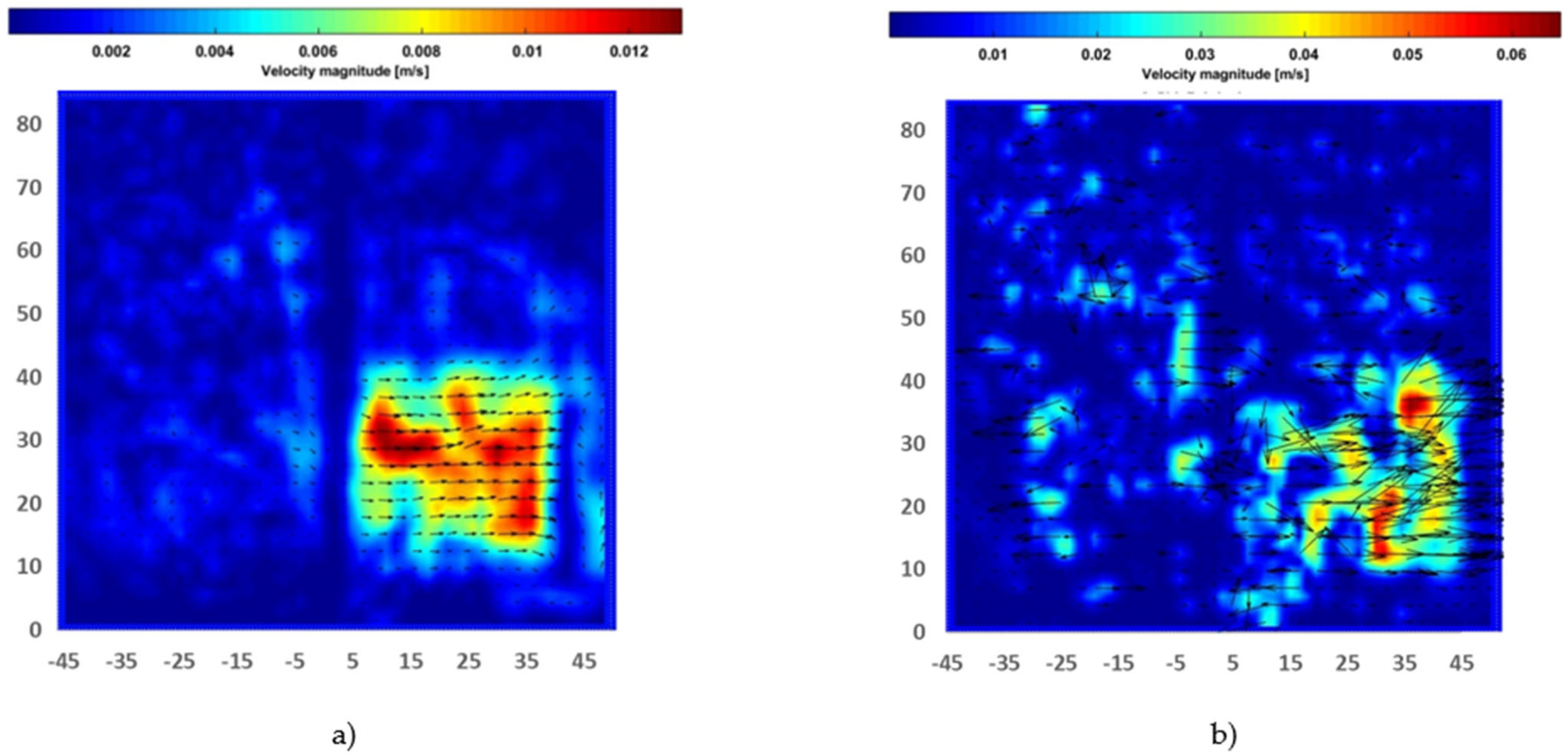


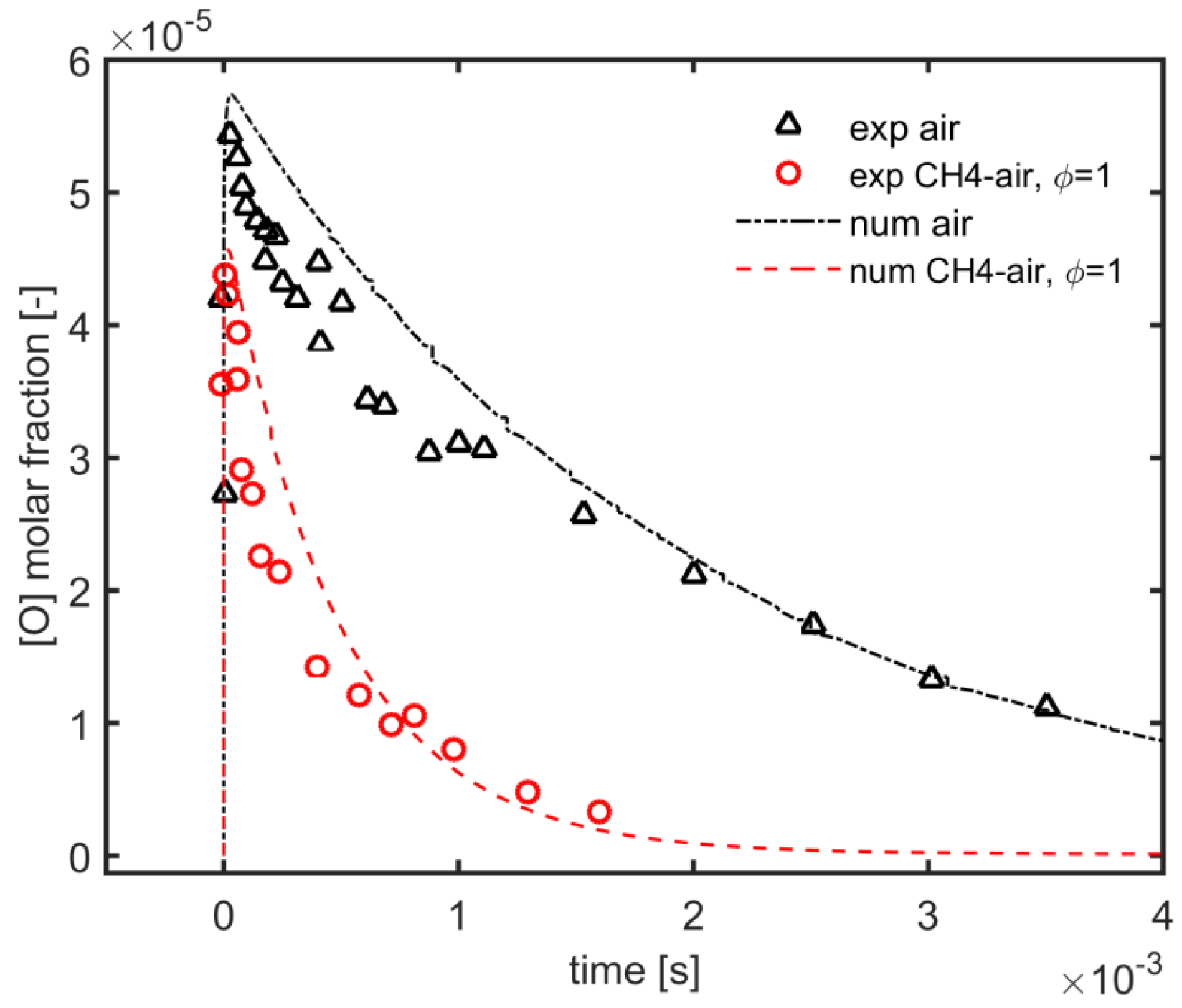
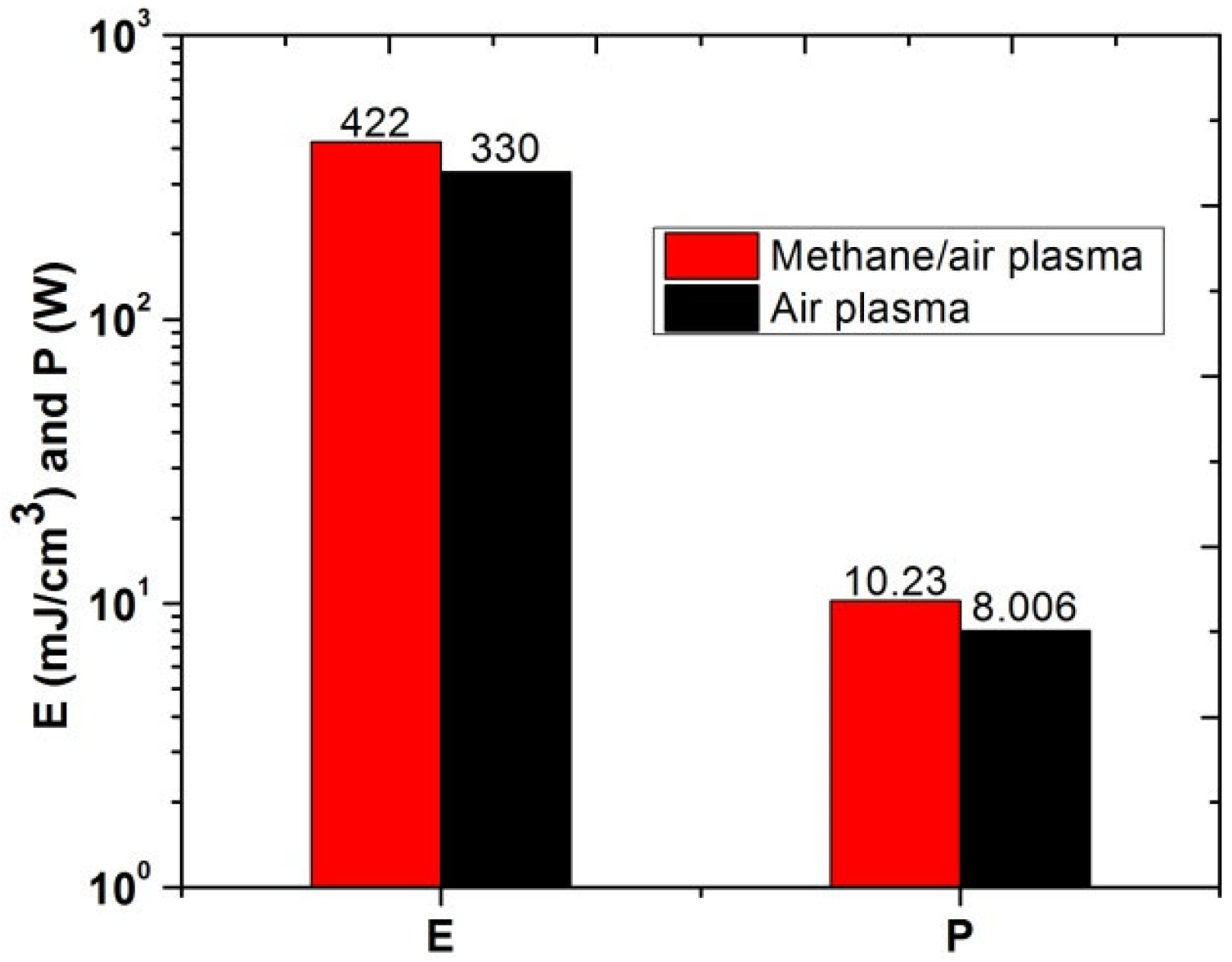
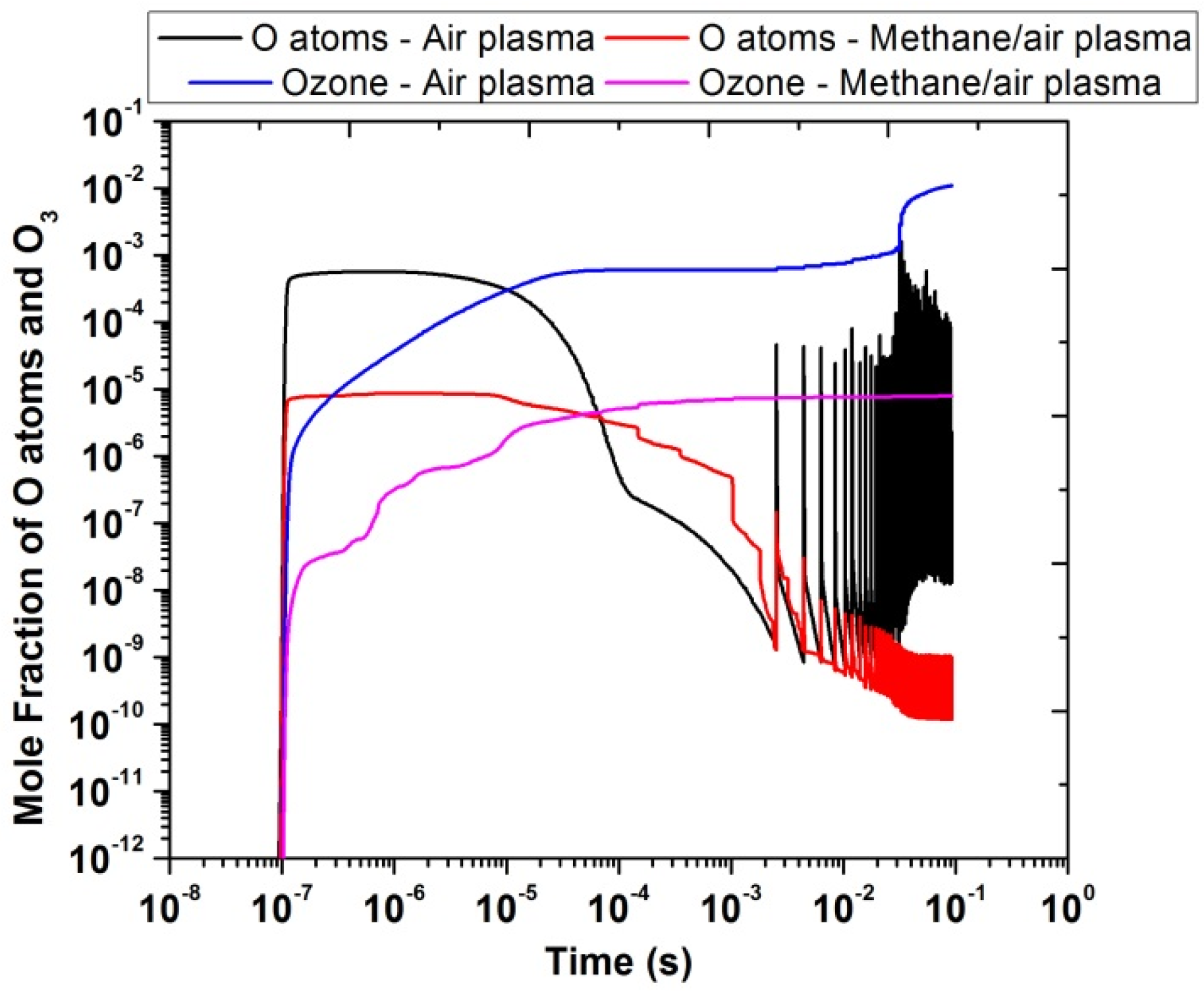



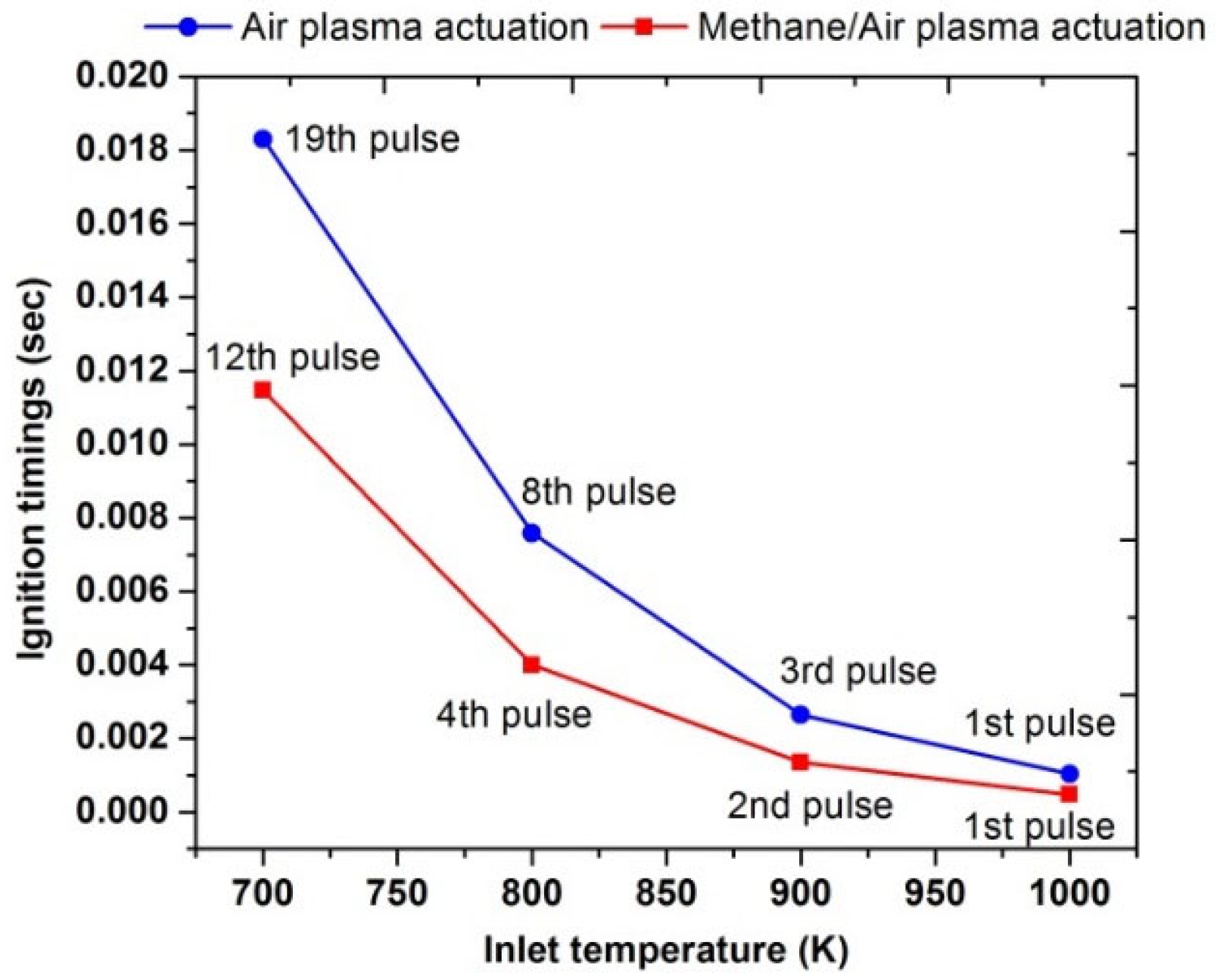




| Test Case | Actuator Configuration | Actuation Conditions | Standoff Distance (mm) | |||
|---|---|---|---|---|---|---|
| No. | High Voltage | Ground | Generator | Amplitude (% Vmax) | Frequency (% Fmax) | |
| 1. | Disk | Needle | Nanopulsed Generator | 40% | 30% | 00 |
| 2. | 20% | 20% | 00 | |||
| 3. | 30% | 20% | 00 | |||
| 4. | 20% | 30% | 00 | |||
| 5. | 30% | 30% | 00 | |||
| 6. | 40% | 20% | 00 | |||
| 7. | 40% | 30% | 40 | |||
| Test Case No. | Voltage Peak (V) | Repetition Rate, F (Hz) | Pulse Electrical Power (W) | Mean Electrical Power (W) | Uncertainty Pulse Electrical Power (W) |
|---|---|---|---|---|---|
| 1. | 16,796 | 755.29 | 660.8 | 1.2 | 70 |
| 2. | 14,600 | 202.18 | 766.2 | 0.4 | 80 |
| 3. | 15,600 | 245.03 | 864.3 | 0.5 | 90 |
| 4. | 14,800 | 627.74 | 790.9 | 1.2 | 80 |
| 5. | 15,500 | 710.22 | 861.3 | 1.5 | 90 |
| 6. | 16,600 | 257.66 | 1029.3 | 0.6 | 100 |
| 7. | 189.98 | 1059.1 | 6.2 | 0.01 | 0.5 |
| Case No. | O | O3 | H | OH | CH | CH3 | Power (W) |
|---|---|---|---|---|---|---|---|
| Methane/air | 8.69 × 10−4 | 7.92 × 10−5 | 4.42 × 10−2 | 1.3105 × 10−2 | 3.39 × 10−4 | 3.084 × 10−2 | 10.23 |
| Air | 3.02 × 10−3 | 1.09 × 10−2 | ---- | ---- | ----- | ----- | 8.006 |
Publisher’s Note: MDPI stays neutral with regard to jurisdictional claims in published maps and institutional affiliations. |
© 2021 by the authors. Licensee MDPI, Basel, Switzerland. This article is an open access article distributed under the terms and conditions of the Creative Commons Attribution (CC BY) license (https://creativecommons.org/licenses/by/4.0/).
Share and Cite
Mehdi, G.; Bonuso, S.; De Giorgi, M.G. Effects of Nanosecond Repetitively Pulsed Discharges Timing for Aeroengines Ignition at Low Temperature Conditions by Needle-Ring Plasma Actuator. Energies 2021, 14, 5814. https://doi.org/10.3390/en14185814
Mehdi G, Bonuso S, De Giorgi MG. Effects of Nanosecond Repetitively Pulsed Discharges Timing for Aeroengines Ignition at Low Temperature Conditions by Needle-Ring Plasma Actuator. Energies. 2021; 14(18):5814. https://doi.org/10.3390/en14185814
Chicago/Turabian StyleMehdi, Ghazanfar, Sara Bonuso, and Maria Grazia De Giorgi. 2021. "Effects of Nanosecond Repetitively Pulsed Discharges Timing for Aeroengines Ignition at Low Temperature Conditions by Needle-Ring Plasma Actuator" Energies 14, no. 18: 5814. https://doi.org/10.3390/en14185814
APA StyleMehdi, G., Bonuso, S., & De Giorgi, M. G. (2021). Effects of Nanosecond Repetitively Pulsed Discharges Timing for Aeroengines Ignition at Low Temperature Conditions by Needle-Ring Plasma Actuator. Energies, 14(18), 5814. https://doi.org/10.3390/en14185814







